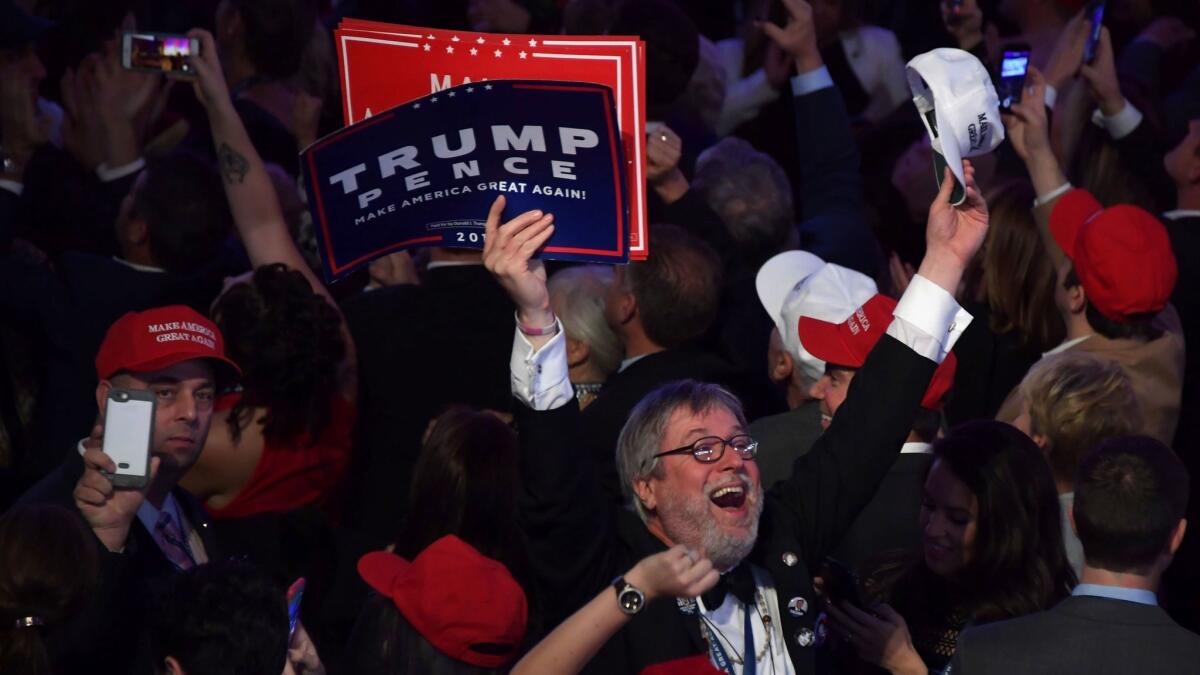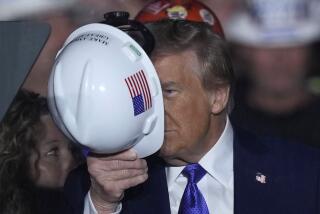How Donald Trump put together such a strong showing

- Share via
Reporting from Miami — The polls, prediction markets and political experts all counted on a win for Hillary Clinton, whether they simply acknowledged Democrats’ many paths to the White House or predicted a sweeping victory that would shift the electoral map.
Donald Trump and the thousands of people at his rallies were just as certain those same experts — the very establishment they were running against — were all wrong.
There was too much appetite for change, Trump and his supporters said. Clinton, in public life for four decades, was too polarizing to capture a divided nation by acclamation, they insisted. The media had become too disconnected to detect the signals, they warned.
“As I’ve said from the beginning, ours was not a campaign,” Trump said in accepting victory early Wednesday after Clinton called to concede, “but rather an incredible and great movement.”
The nature of the race may have come as a surprise to political analysts from both parties, but the signs were there all along. Trump’s defiance of political convention began on the the day he announced his presidential campaign and never stopped.
Live U.S. election results | Live California election results
Trump spoke often of the June referendum in Britain, where a majority voted to leave the European Union. “Brexit times five!” Trump said at a rally in Pennsylvania. But while a popular notion has taken hold that the polls did not predict that vote, that is not true; several predicted the outcome but were ignored by the betting markets and pundits who played up their preferred outcome.
The similarities were clear. Both movements were fueled by working-class whites, who felt left behind amid cultural and economic changes.
Experts warned of dire consequences, to the economy and to national standing, if voters in Britain chose to leave Europe or voters in the U.S. chose Trump. The same experts were sure that voters would follow their lead.
Yet these voters scoffed at those elites as they raged against globalization and immigration, deciding it was worth the gamble to disrupt a system they saw as corrupt.
“He has stood up for the people that don’t have a say,” said Tammy Tavalsky, a 50-year-old who owns a printing company with her husband and attended an especially raucous rally in Johnstown, Pa.
Tavalsky, like many Trump supporters, expressed fear that people were coming into her city from elsewhere to collect food stamps, welfare and other benefits at the expense of locals.
“The middle people are paying for it,” she said.
Even as Trump would seem to wound himself with bombastic insults, racially charged rhetoric, revelations of past misdeeds, gratuitous airing of grievances, or ill-considered policy proposals, his supporters forgave, agreeing with him that the “dishonest and corrupt media” were stacking the deck to protect the establishment. More reluctant supporters joined in because they worried about control of the Supreme Court or simply did not trust Clinton.
“There’s no perfect human being,” said Joyce Case, a 56-year-old cosmetologist from Fletcher, N.C. “He has nothing compared to what the Clintons have done in office, both of them.”
At a low point last month, following the discovery of a 2005 recording in which Trump bragged about groping women, some of his party’s leaders began abandoning him. Polls started to show Clinton pulling ahead by increasingly large margins, a lead that threatened to spill into congressional races and endanger Republicans’ control of the Senate and even their double-digit margin in the House.
People on Trump’s own team questioned both his viability as a candidate, and a strategy that seemed off the cuff at best and self-destructive at worst.
“He has absolutely no electoral reason to be in Wisconsin!” grumbled one despondent GOP official after a rally in Green Bay that seemed designed as much as anything to settle a score with House Speaker Paul D. Ryan, the Republican from the state who backed away from Trump after the 2005 recording was made public.
But Trump plowed on, insisting that polls were underestimating his support, either deliberately to depress turnout or because they failed to detect the enthusiasm he saw at airplane hangars, convention halls and fairgrounds in Colorado, North Carolina and even Minnesota. (There is no evidence of poll manipulation.)
As Trump struggled in the polls, Clinton tentatively branched out beyond the states she needed to win, such as Michigan, Wisconsin and Pennsylvania, in hopes of broadening the map to include Arizona. After building big leads in Virginia and Colorado in July and August, she pulled her advertising to marshal resources elsewhere.
It wasn’t just cockiness, though that may have played a role: Clinton and her team believed they needed to drive up support in states with high Latino populations to counter Trump’s advantages with working-class whites.
By last weekend, hints emerged that Clinton’s gamble could backfire. Though polls showed her with small leads or ties in most of the battleground states, she lacked the cushion that Obama had four years earlier.
And Trump, left for dead only weeks earlier, began taking an even more aggressive posture. His campaign manager, Kellyanne Conway, insisted Sunday that the campaign had at least six combinations of states that could bring victory.
Clinton, her husband, Obama and other top surrogates were scrambling back to seemingly safe harbors such as Michigan and Virginia.
“They’re chasing us around in these blue states,” Conway taunted in a conference call with reporters. “We’ve been expanding our map, and we are now competing in states where people wrote us off months ago.”
In a move of striking audacity, Trump held a rally at a Minneapolis airport hangar Sunday, drawing thousands in a state that Republicans had not won since 1972, the longest streak in any state.
After midnight of a marathon day, Trump arrived in Virginia, his fifth state of the day. Hundreds of people – not as many as Trump claimed but still quite a few considering the hour -- crowded outside the fairgrounds to cheer Trump on when they could not fit inside.
“We are going to have one of the greatest victories of all time,” Trump told them. “This is going to be Brexit times 50.”
Twitter: @noahbierman
How Donald Trump put together such a strong showing in the presidential election results
Financial markets tumble amid Trump’s surprising election-night performance
Whatever happens, one things seems certain in Congress: continued partisan gridlock
UPDATES:
12:15 a.m: This story was updated with Trump winning the presidency.
This story was originally published at 10:05 p.m.
More to Read
Get the L.A. Times Politics newsletter
Deeply reported insights into legislation, politics and policy from Sacramento, Washington and beyond. In your inbox twice per week.
You may occasionally receive promotional content from the Los Angeles Times.











